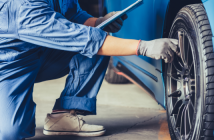Who doesn’t love a good road trip? You’ve got your playlists organized, your snacks stashed and your bags packed….you are ready to hit the road!
But wait….not so fast. What about your ride? Is your vehicle really ready to tackle a lengthy on-road adventure? In other words, if you take off without tending to some preventative auto maintenance first, you are at risk of making a very different set of memories than the ones you were hoping to make.

In this article, learn the steps to take to make sure your vehicle is as ready for your big road trip as you are!
Step 1: Check and top off all fluids.
Even if it is the dead of winter or high summer where you are now, you may find just the opposite weather cropping up as your road trip continues. You want to be ready for an all-weather experience even if you don’t anticipate that happening. So be sure all vehicle fluids are topped up before you back down the driveway.
Fluids to check include: Coolant, Windshield wiper fluid, Brake fluid, Power steering fluid, Transmission fluid, Radiator fluid, Oil.
Step 2: Change your oil.
Unless you just had your oil changed and haven’t logged many miles since, it is always a good idea to take care of this regular maintenance task before leaving for an extended trip.
As well, experts recommend that most vehicles have the oil changed every 3,000 to 6,000 miles (depending on whether you use regular or synthetic oil and what type of engine your vehicle has).
If your road trip will take you further than that, it can be a good idea to set up a future alert to prompt you to change the oil again mid-trip.
Step 3: Inspect and inflate your tires.
Worn tires are not the kind of tires you want underneath you on a long road trip (or even a short road trip, for that matter). Worn tread can quickly turn into stripped tread and a blowout in the middle of nowhere.
You can do a simple test with a penny to check your tread. Stick the penny in between the tread and mark where on the penny the tread reaches. If this measures less than 1/16th of an inch, safety indicates a tire replacement may be in order.
Even if your tires are new and pristine, be sure they are inflated to the full manufacturer’s recommended PSI. This will give you the best gas mileage and save you money on gas and future wear and tear repairs on your vehicle. Having fully inflated tires will also keep you safe in inclement weather.
NOTE: Don’t forget to also check and inflate your spare tire!
Step 4: Make sure you have working emergency gear on board.
You just never know what may unfold when you are out driving on the open road. Of course, this is a big part of the allure of taking a road trip!
But there isn’t much that is alluring about a flat tire, an overheated engine or an iced-over windshield.
In addition to carrying emergency gear for your vehicle, you should pack emergency supplies for yourself.
Consider stocking the following:
– Hard-copy maps (you may not always have access to GPS and a cell phone signal).
– Flares and flashlights WITH working batteries.
– Full size spare tire.
– Tire puncture repair kit.
– Jack and lug wrench.
– Jumper cables.
– Snow and ice scraper.
– Emergency hot blanket.
– Basic toolkit (screwdriver, pliers, wrench, et al).
– Basic first aid kit.
– Fire extinguisher.
– Shovel.
– Blanket.
– Bottled water and nonperishable emergency snack foods.
Step 5: Do a brakes, signals and a lights check.
You definitely don’t want to start your road trip by skidding into the back of another vehicle, or a tree, or anything, because your brakes suddenly go out.
You also don’t want to find out via a set of flashing blue and red lights and an expensive ticket that you have a signal light or head light out.
So do yourself and your budget a favor and check before you depart to make sure that your brakes, signals and lights are in good working order.
Step 6: Replace wiper blades and belts as needed.
If you will be driving through rainy or icy weather, you will thank yourself a hundred times over for replacing worn-out windshield wiper blades before you left. There is nothing quite so wonderful as turning on the windshield wipers and suddenly having a clear window to look through!
While you’re at it, take a look at the belts (or have your mechanic do it) and just make sure they are not worn, cracked, crumbling or rotted out.

Step 7: Give everything a good cleaning.
Finally, everything just looks better and brighter when it is clean. This especially includes windows, windshields, mirrors and light fixtures (you might be amazed at how much brighter your headlamps seem after you clean the glass covering them!).
If you plan to do early morning or late night driving on your road trip, you are likely to encounter some pretty large and, well, juicy insects. Depending on the terrain where you are headed, you may also encounter dust, debris, mud, red dirt and other detritus that can handily and expediently obscure your vision behind the wheel.
So you will probably thank yourself later for tucking some extra-tough cleaning solution in now with your emergency supplies. After all, you want to actually be able to see the roadside scenery when you are driving by it!
By following these seven steps to vehicle road trip readiness, you can prepare for a trip that will be safe and fun and very memorable – in the best possible way!
Use the info-graphic below as a cheat sheet.








